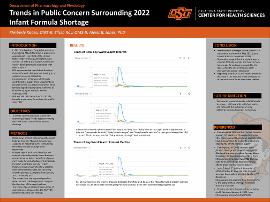| dc.contributor.author | Kaase, Kimberly | |
| dc.contributor.author | Ray, Elissa | |
| dc.contributor.author | Jones, Alexis B. | |
| dc.date.accessioned | 2023-11-02T20:45:54Z | |
| dc.date.available | 2023-11-02T20:45:54Z | |
| dc.date.issued | 2023-02-17 | |
| dc.identifier | ouhd_Kaase_trendsinpublicconcernsurrounding_2023 | |
| dc.identifier.citation | Kaase, K., Ray, E., and Jones, A. B. (2023, February 17). Trends in public concern surrounding 2022 infant formula shortage. Poster presented at Research Week, Oklahoma State University Center for Health Sciences, Tulsa, Ok. | |
| dc.identifier.uri | https://hdl.handle.net/11244/339900 | |
| dc.description.abstract | Background: The beginning of 2022 was marked by Food and Drug Administration’s investigation of Abbott Nutrition, a producer of approximately one-third of the United States’ baby formula (Cunningham, n.d.). After report of a third and fourth Cronobacter case of death potentially associated with their products, the FDA recommended that Abbott Nutrition voluntarily recall their product, leading to a voluntary cease in production. Russia invasion of Ukraine additionally contributed to supply chain uncertainty as Ukraine served as a major exporter of infant formula ingredients including sunflower oil (Timeline of Infant Formula Related Activities, n.d.). In order to better understand public concern, we examined Google Trends data surrounding the 2022 United States infant formula shortage. The results of this study have important indications concerning infant health and existing disparities for low-income families. | |
| dc.description.abstract | Methods: Our team began by researching the dates, news articles, and AAP/FDA recommendations and findings surrounding the infant formula shortage. Using Google Trends to collect data, we entered various key words found from our research that included “baby formula near me”, “baby formula shortage”, “homemade formula”, and “baby formula recipe” into Google Trends. The parameters we set were to show searches done in the United States and occurring over the previous 12 months from January 2022 to January 2023. After each trend was found, we compiled key word searches onto one line graph to compare the timelines of the trend data. We then determined the times of peak interest and compared them to the AAP/FDA recommendations and findings. | |
| dc.description.abstract | Results: According to the Google Trends data, all searches showed a peak interest from May 8th to May 21st. “Baby formula shortage” had the highest search interest. “Homemade formula”, “baby formula recipe”, and “baby formula near me” at their peak interest had 12%, 11%, and 7% of the searches that “baby formula shortage” had, respectively. For all four searches, the interest dropped drastically from May 21st to June 4th. “Baby formula shortage” searches decreased to 12% of its peak interest going into June and was at 4% of its peak interest going into July. | |
| dc.description.abstract | Conclusions: Our results suggest that the highest search volumes corresponded to the dates when the infant formula supply shortage was at its lowest, spiking to over 74% nationwide at the end of May 2022 (Laura Stilwell and Lisa A. Gennetian, 2022). | |
| dc.format | application/pdf | |
| dc.language | en_US | |
| dc.publisher | Oklahoma State University Center for Health Sciences | |
| dc.rights | The author(s) retain the copyright or have the right to deposit the item giving the Oklahoma State University Library a limited, non-exclusive right to share this material in its institutional repository. Contact Digital Resources and Discovery Services at lib-dls@okstate.edu or 405-744-9161 for the permission policy on the use, reproduction or distribution of this material. | |
| dc.title | Trends in public concern surrounding 2022 infant formula shortage | |
| osu.filename | ouhd_Kaase_trendsinpublicconcernsurrounding_2023.pdf | |
| dc.type.genre | Presentation | |
| dc.type.material | Text | |
| dc.subject.keywords | baby formula shortage | |
